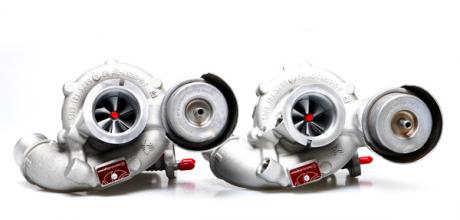Porsche and turbocharging

The Turbo moniker is well established with the 911. But what is a turbo, and why are they used?
Technology explained
An engine needs two ingredients to run: fuel and air. In sports cars such as the 911 where performance is the ultimate focus, you’d expect to simply turn up the wick to increase fuel, and hey presto, instant performance, right? Wrong. The combination of air and fuel is set to a fine balance, the so-called stoichiometric mixture of 14.7:1. For more fuel, the air must increase to match, but ambient air pressure dictates the amount of fuel needed to balance with 14.7 parts of atmosphere. That’s where the turbo comes in.
In simple terms it is a turbine, which forces compressed air – sourced from the exhaust gases – back into the engine intake. More air at greater pressure means more oxygen, so fuelling can be increased. The extra oxygen allows a better burn of the fuel, so results in a bigger bang, basically. Which is why Porsche turned to a turbo for the 911, first racing one in the 1974 Carrera RSR Turbo 2.1. The first 911 road model to use a turbo was the 2.7 Turbo prototype of 1974 that was given to Louise Piëch.
Simple, reliable and effective, a turbo isn’t without problems. Chiefly, being driven by the exhaust gas means engine revolutions need to increase before the turbine fans in the turbo take effect, and generate overpressure. This is the legendary turbo lag the first production 911, known as the 930, is known for. At 3,500rpm the 0.8 BAR boost kicks in, and with it a jump in engine output, famously catching out the unwary. Therein lies the issue. A big turbo may give a big bang, but takes a while to spool up, and the effect is rather pointed. A smaller unit spools up quickly, but struggles to maintain performance at high revs and maximum engine demand.
To get around this issue, Porsche eventually used twin turbos, first appearing on the 959. Working sequentially, a smaller unit kicked in at low revs, then a second, larger one operated at higher rpm. Twin turbo technology first appeared on a production 911 in 1995, on the 993 Turbo. In contrast to the 959, the 993 setup operated both turbos in parallel, each supplying its own cylinder bank.
Porsche pushed the technology further and introduced Variable Turbine Geometry in 2005 on the 997 Turbo. At low revolutions, the turbo vanes angle down, pushing air more quickly, increasing pressure. As boost increases with revs, the vanes open electronically, to meet the higher demand. The VTG technology combines the benefits of a small and larger turbo in one, giving the flat, endless torque curve of the 997.
The use of a turbo dictated the Turbo title, and today, twin VTG turbos still feature on the top-of-the-range Turbo, despite Carreras now being turbocharged.

